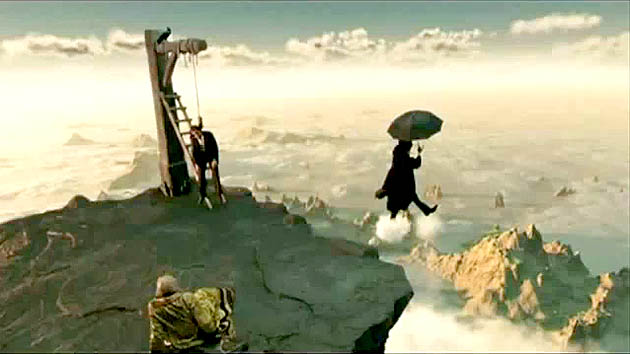David Warren

So in a way he raises the bar very high in terms of art department work but the trouble is it’s all that much higher to jump over! People ask what was the most difficult aspect of the film. Well, in the opening stages it was just sheer quantity. I know there were two designers but it felt like we were doing two movies in a way. We were doing a physical one with normal set decoration, props, art direction, the wagon, and all that kind of shmutter, and then we were doing a visual effects movie through the mirror, 650 shots. I know a lot of people talk about Avatar being the world that was explored to the nth degree, which was fantastic, but every time we went through the Imaginarium mirror Terry wanted to see something different. It was a very labor-happy film from that point of view.
AS: You yourself do a lot of the sketches?
DW: I do, yeah, because that’s my background. I come from a background of illustration so the first thing I reach for in any situation is a pencil. And in the early stages we were hammering out drawings on the drawing board. When Terry likes it he comes over and puts his fingers all over it and it gets messy. Then he grabs a pencil and he starts scribbling on your drawing. That’s the language that we used to make decisions. Because the trouble with Terry is that ideas, when they are written in the script by him and Charles, read very esoteric. I mean, when I first read the script with some of the landscapes I didn’t know what the hell they were talking about. You’ve got to see the image and as soon as you see the image you go, Oh, that’s the shape of the mountain. Oh, that’s what you mean by the balloon…
AS: It was you and Anastasia Masaro working together at all times?
DW: No, because in the history of the film I came on earlier than she did. When I came on I hit the ground running and I started sketching and drawing. She came on the set six weeks or so later and then she had to get up to speed very quickly in England. So we prepped it together in the UK and the plan was always that she would run the Canadian half of the shoot. That was the sets that went on blue-screen stages and some locations and also anything we didn’t complete in and around the wagon. So that’s more or less how we divided the work.
AS: Did you enjoy working with Peerless and with visual effects in general as a designer?
DW: I get a huge kick out of it. The effects work in a visual effects film is integral to the design which is why Robert Stromberg’s work became so integral to Rick Carter’s on Avatar.
You break it down around a big table. You go through the sequences at length, talk through the line between physicality, miniature, and CG. That’s always a negotiation around a table -you don’t go and decide in that in a closed room. You’ve got to sit together and say, What if we build that? You sure you need that? Well, hang on a minute that’s grass so we do need that because it’s a hell of a thing to do digitally. No matter what we do in the future, films will always be made by people, not computers. The way that it is thrashed out is by people talking over endless nights and cups of coffee!
Pingback: Guy Hendrix Dyas
Pingback: Dante Ferretti